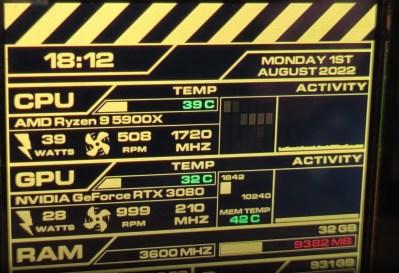The visually striking hardware monitor that [Mangy_Dog] recently put together for his new custom PC build might look like something out of the Alien franchise, but the hardware he’s built it around actually comes from a very different science-fiction property: Star Trek. Or at least, from a very impressive line of Star Trek props, anyway.
 Given the incredible amount of time and effort that [Mangy_Dog] has put into developing his Star Trek: Voyager tricorder, it’s no surprise that he would decide to reuse its graphics chip and microcontroller. But while the familiar hardware might have helped jump-start this build, this was no weekend project.
Given the incredible amount of time and effort that [Mangy_Dog] has put into developing his Star Trek: Voyager tricorder, it’s no surprise that he would decide to reuse its graphics chip and microcontroller. But while the familiar hardware might have helped jump-start this build, this was no weekend project.
He’s steadily been working on it for several months now, and even entered it into the 2022 Sci-Fi Contest back in April. Obviously he wasn’t able to complete it before the Contest deadline, but looking at the final results, we’re happy to see he kept chugging away at it.
Of course, with a project like this, the hardware is only half the battle. In the video below, [Mangy_Dog] explains the challenges involved in creating not only the firmware that runs on the monitor, but the accompanying PC-side application. This included modifying existing libraries to add support for the device’s unique flash storage arrangement, and pulling the relevant system status information out of the operating system and into a series of customizable widgets.
As impressive as the project is, [Mangy_Dog] says he’s not done yet. A second revision of the hardware and software will address several issues and add new capabilities, and considering the high degree of polish we’ve come to expect from his creations, we’re not surprised

















Is there a place that has style guides or something similar for sci-fi franchises, or do people just really watch and look closely and come up with there own?
It’s an aesthetic style, which means it’s merely a loose set of rules, Provided sufficient input of images matching the style, a neural network could easily generate something to match. That fact that you can recognize the style means you have this capability.
Try this: https://typesetinthefuture.com/
I would be a lot more impressed if the whole thing had been constructed using edge lit acrylic. It might not have been quite as visually striking but it would radically reduce reproduction expenses. There is something to be said about someone who has a custom display that costs more than rest of the PC.
It will be edge lit… in phase 2 :p though I was going to do it in phase 1, I just came up with a better more compact design for it… So phase 2…
Also currently its not really possible for me to have a display embedded into acrylic :p
Or transparent PCBs with transparent components. Though that would be cool!
Yes! And no…
I like the idea of having operational data readily displayed, but it seems too much yellow makes it harder to view.
The primary colour is easily changed. Its a single value :)
Could it have been an off the shelf tablet put into a laser cut “enclosure”? Not quite sure how this isn’t, well, a $100 tablet plus some neat software?
The software (Android?) side seems somewhat interesting and not exactly trivial or quick to do. Is there a better way to do that? Something like real time HTML updates or JS that you just send it information to? Could it be an ARM tablet running Linux? Seems like it has a lot of requirements imposed and that may be due to the goal for this project? Not saying it is not impressive, just not following quite why some steps seem to have taken a lot of time to go from 95% to 99% polish?
If you check the video I go over what it is… Its not a tablet.
Its an embedded project.
That makes sense and I do follow that but why an embedded project specifically I guess?
Because Im an embedded developer :p
Would you consider creating an app that emulates the device for use under Windows/Linux. Maybe even an API for us who like to tinker?
All the heavy lifting is actually on windows already, using libre hardware monitor as the main api to gather all the data.
The hardware renders the UI and uses the data being fed to it to display.
this guy does the same with an lcd for aorund £99 https://www.youtube.com/watch?v=7bXcojLipME
What he did is very different to what I did. I developed a display from scratch, he installed a hdmi monitor into his case.
The UI design looks less Aliens (no Semiotic at al! And too little pure text and fine vector linework) and more NERV, particularly with the warning stripes.
case panel looks sick, nice work